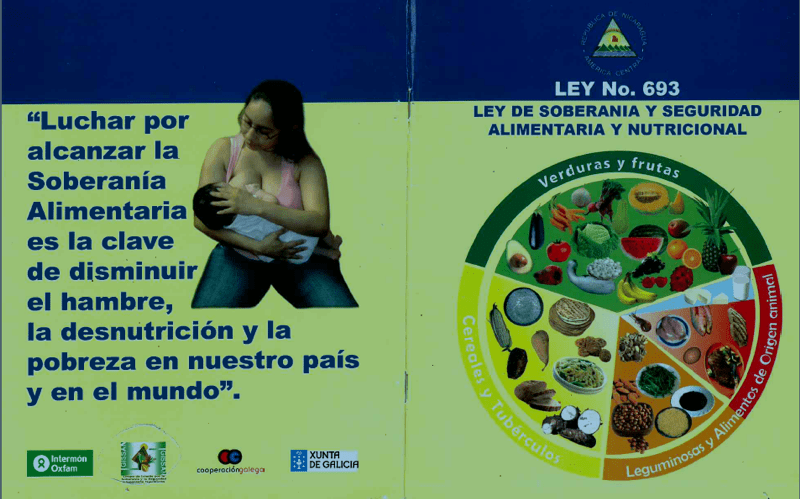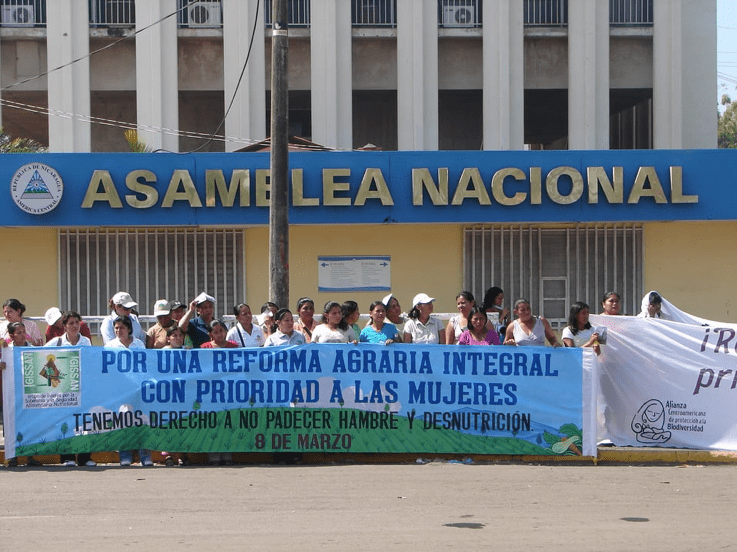A Tale of Two Food Sovereignties
I first learned of food sovereignty while I was completing my graduate work in Global Affairs at Rutgers University. I had developed an interest in agrarian and food movements, and particularly an agrarian movement of banana workers seeking justice after being exposed to the pesticide, Nemagon, in Nicaragua. The study of the movement piqued my interest and I ended up going to Nicaragua over the summer in 2005 to do some volunteer work with the Asociación de Trabajadores del Campo(ATC), a historic Nicaraguan mass organization created by the Frente Sandinista de Liberación Nacional (FSLN) in the years prior to the 1979 insurrection. It was during these months of engaging with the ATC in Nicaragua that I was introduced to the concept of food sovereignty. Put simply, food sovereignty is the right of peoples to define their own food and agriculture systems and their right to culturally appropriate, sustainably produced food. It is a strategy for achieving food security and realizing the human right to food by challenging the dominant corporate food system. The ATC is a founding member of the transnational peasant network, La Vía Campesina (LVC), the organization credited with introducing food sovereignty to the international community at the World Food Summit in 1996.
Several years after I first learned of food sovereignty, when I was preparing to write my doctoral dissertation proposal, I found out that Nicaragua had passed a national law recognizing food sovereignty, Law 693, the Law of Food and Nutritional Sovereignty and Security, in 2009. Thus, Nicaragua had become one of a handful of countries (mostly in Latin America) that had institutionalized food sovereignty in national policy. I decided to examine the law in my doctoral research, namely the process of formulating and negotiating the law to identify the factors that influenced its adoption and the outcomes of this process. In addition to documenting the process of making the law, the study also sought to explore the different meanings and interpretations of food sovereignty among vested actors, as well as the history of food sovereignty in Nicaragua.
When I arrived in Nicaragua in 2011 to start my fieldwork, my perspective was largely informed by the contacts I made through my colleagues at the ATC and others I had met while networking with the transnational food sovereignty movement. One of the assumptions I had going into the research was that Nicaraguan members of the LVC, like the ATC, had played a strong role in the law. And they did, and in fact they were central to the process and largely credited with getting the law passed. However, there were other stories I did not expect to encounter. Among them was the controversy over how the law defines food sovereignty. More specifically, the law includes two distinct definitions of food sovereignty. The first of these appears in Article 2 and defines food sovereignty as:
The right of the people to define their own policies and sustainable strategies for the production, distribution, and consumption of food that guarantees the right to food for the entire population based on small and medium production, respecting their own cultures and the diversity of peasant practices, fishing and indigenous modes of agricultural production, commercialization and management of rural areas, in which women play a central role. Food sovereignty guarantees food and nutritional security.
The second appears in Article 9 and defines food sovereignty as the following:
Without detriment to what is defined in Article 2, number 1 of the present law, food sovereignty in the right of the State to define its own policies and sustainable strategies for the production, transformation, distribution, and consumption of food that guarantees the right to food for the entire population with preference for the valorization and consumption of national products without prejudice to the exercise of the right to free enterprise and trade.
Both definitions are considerably different. The first defines food sovereignty in the spirit of the transnational food sovereignty movement’s approach to food sovereignty, which has evolved from the framework introduced by LVC in 1996. In contrast, the second definition emphasizes the political authority and autonomy of the state (basically state sovereignty)—instead of the people—to decide food policies, whilst making room for the interests of larger enterprise, namely in term of industrialized production and free trade. Thus, these two definitions reflect different ideological views among key actors in the food security policy field and leave the concept of food sovereignty unclear in the law. So what happened?
Responding to this question of how these two definitions made it into the law requires stepping back into the history of the law, and to get there we need to look at the origins of food sovereignty and the food sovereignty movement in Nicaragua.
Food sovereignty’s conceptual roots in Nicaragua can be traced back to the Sandinista-led Revolution in the 1980s. Food security was a priority during the Revolution, initially because of the food insecurity problem that the Sandinistas inherited at the onset of the Revolution, later exacerbated by the Contra War and the U.S. economic embargo. Through two key policies—agrarian reform and the Programa Alimentario Nacional, a national food program—Nicaragua aimed to deepen food security through self-sufficient production and a network of distribution centers. This represented the first time any Central American government committed itself to achieving the Right to Food.
Ortega’s administration had a strong interest in addressing food insecurity. Upon taking office in early 2007, he created the Consejo Nacional de Seguridad y Soberania Alimentariaand appointed as its head Orlando Nuñez, a loyal Sandinista militant who had worked for the Revolutionary government. Later that year, Ortega introduced the cornerstone program of the government’s social policy, Hambre Cero, which included the Bono Productivo Alimentario(BPA) aimed at reducing poverty in rural areas and enhancing food security by fostering family-level crop and animal production for personal consumption and sale of excess. Hambre Cero was the government’s key program for fostering national food sovereignty, and Orlando Nuñez was the architect behind the program and was made its director later in 2007. The BPA was implemented at the local level by the Comités de Poder Cuidadano(CPCs), which were part of a new political apparatus implemented by presidential decree to promote participatory, direct democracy.
The renewed interest in food security coupled with increasing regional initiatives for food sovereignty created political opportunity for GISSAN’s food sovereignty bill. In 2007, the bill was introduced to the floor of National Assembly for debate. After approving the first four articles, the debate stalled and was ultimately suspended over controversial provisions to promote food sovereignty, namely restrictions on food aid containing genetically modified organisms and preferential treatment for small and medium producers. Representing the interests of their private sector constituents, the right-wing Partido Liberal Constitucional(PLC)objected to these provisions and attacked the definition of food sovereignty presented in Article 2 of the law. A lengthy negotiation process ensued between various stakeholders: the government, the private sector, GISSAN, peasant organizations and the UN Food and Agricultural Organization (FAO), brought on as a technical adviser by the government. Ultimately, controversial elements were removed, a second definition of food sovereignty was added (see Article 9 above), and a multi-scale system of governance was created consisting of municipal, departmental, and national institutions for policymaking on food and nutritional sovereignty and security. In June of 2009, the law was approved by the National Assembly. While generally heralded, it was also criticized by organizations such as GISSAN for not going far enough to institutionalize fundamental food sovereignty principles.

Front and back cover of a book used to raise awareness about Law 693. Source: The Author’s Collection
The two definitions of food sovereignty in the law point to the broader lack of agreement among food policy actors in Nicaragua over what food sovereignty means. At first glance, this appeared to be more of a conflict between civil society members of the food sovereignty movement and the private sector. However, as I would discover later, the state was the far more curious actor in this scenario—mainly because the Ortega government had from the onset adopted food sovereignty into its food security approach, but simultaneously made clear its interest in cooperating and collaborating with the private sector. In fact, key FSLN leaders were part-owners of large agribusinesses. Ultimately, this had significant implications for how food sovereignty was put into practice.
Following Law 693’s approval, GISSAN, peasant organizations, the FAO and other stakeholders went to work to implement the law. One of the first actions taken by these groups was to begin establishing the Comités Municipales de Soberania y Seguridad Alimentaria y Nutricional(COMUSSANs), local policy-making and coordination bodies comprised of state institutions, civil society groups, and local government officials, to foster food and nutritional sovereignty and security as mandated by the law. The COMUSSANs were charged with local policymaking and coordination. GISSAN member organizations also began pushing for local policies to rescue elements of food sovereignty that had not made it into the national law such as municipal ordinances banning genetically modified organisms from municipal territories.
At the national level, however, there was strong concern at the time of my fieldwork in 2011-2013 that the government was doing little to implement the law. Few of the national-level institutions had been formed, and the few that were formed met infrequently and irregularly. In the 2012-2016 National Human Development Plan, the government reiterated the centrality of Hambre Ceroto its food security approach. The Food Strategy and Food and Nutritional Sovereignty and Security Policy presented in the plan underscored the top-down approach of the state, as reflected in the definition presented in Article 9 of the law, while still calling for the creation of the multi-tiered SSAN governance institutions. Food sovereignty, according to the policy, is equated with family and national food self-sufficiency and achieved by expanding production through the development of a “family, community, cooperative, and associative economy,” essentially the goal of Hambre Cero.
This echoes important aspects of the food security strategy implemented by the FSLN during the Revolution, and while aspects of the approach resonate with the food sovereignty movement’s interpretation of food sovereignty, the fundamental right of people to define their own food system policies and practices is overlooked. Rather, several contradictions are revealed: on the one hand, while attempting to implement a system of direct participatory democracy, bottom-up by nature, the system put in place by the Ortega government of the local level CPCs implementing the state policies for SSAN evidence a top-down approach that was later found to have clientelist attributes. On the other hand, while professing its intention to implement Law 693, the government displayed little political will to implement the pluralist and inclusive policy-making spaces created by Law 693 in practice. The FSLN-dominated CPCs, later replaced by the Gabinetes de Familia, Comunidad y Vida, and other state actors were found to drive policy in some established COMUSSANs, pushing the national agenda of the Ortega regime instead of nurturing the voices in the municipalities to formulate policies from below. Civil society participation in these spaces grew increasingly smaller in parallel with the narrowing of civil society mobilization in general as the Ortega government continued concentrating its power.
The ATC, the organization that first introduced me to food sovereignty and the national expression of LVC, is still organizing around food sovereignty in Nicaragua, even amidst the deep, on-going socio-political crisis that has characterized the Nicaraguan landscape for nearly 18 months. Against this backdrop, food security is and will continue to be an important issue, especially in light of the deteriorating state of the economy. In solidarity with the Ortega government, they have denounced the alleged right-wing “coup” to overthrow the government last April 2018 and continue to work towards building the solidarity economy with the government to ensure food security and food sovereignty, the latter understood by the Ortega regime as food self-sufficiency. Given their historical allegiances to the FSLN, their position on the current crisis is unsurprising. However, it places the ATC, as the national expression of LVC, in an intriguing and contradictory position: how to promote food sovereignty in the spirit of LVC as the right of people to define their own food and agriculture systems—which fundamentally demands democracy, while maintaining loyalty to an increasingly undemocratic regime.
The author would like to thank Katharina Schiller for her thoughtful comments on an earlier draft of this piece.
Spring/Summer 2019, Volume XVIII, Number 3
Wendy Godek is an Assistant Professor in the Department of Politics and International Relations at Roger Williams University, where she is also a member of the Latin American and Latino Studies faculty and affiliated with the Public Health program. Prior to joining RWU, she lived and worked in Nicaragua for nearly seven years doing agricultural and rural development work. Her areas of research include food and agriculture politics and policy, sustainable rural development, gender, and social justice movements.
Related Articles
The University and the Nicaraguan Crisis
English + Español
University youth were the first to rise up in April in Nicaragua. Then other young people followed en masse, followed by the rest of the population. The young students woke up an entire country. “They are students; they are not delinquents!” became the first slogan that…
Nicaragua TEMPLATE: Single Language Article
English + Español
A one or two sentence blurb about the article
3, 2, 1… poemas
Manual para sobrevivientes…




